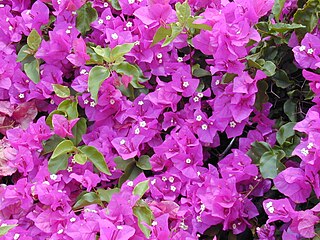
Use in home gardens:
Bougainvillea's growth habit and beautiful showy bracts make it a popular plant for landscapes. It is used in mass plantings, as shrubs or bushes, and as ground cover on banks. Bougainvillea provides hedges, barriers, and slope coverings. For large, difficult-to-maintain areas, bougainvillea is an excellent ground cover. It can cover a whole hillside and can control weed growth. Dwarf cultivars make colourful ground covers. Bougainvillea can be trained as a "standard" a small flowering tree with a single trunk over arbors, into espaliers, onto walls, or to cascade down a slope. Bougainvillea is used as an accent plant, a specimen plant, in hanging baskets, in containers, and for bonsai. Give plants enough space to grow to maturity without being crowded. Most cultivars do well 6-9 feet apart. Bougainvillea should not be planted within 4 feet of walkways, as the thorns could cause problem to passersby. Flowering is promoted by short day lengths. In addition, cultural practices are important to ensure satisfactory flowering and avoid overwatering, overfertilizing with nitrogen, putting plants in heavy shade, and pruning too frequently.
Climatic requirement:
Bougainvilleas are hardy plant and can be grown in any conditions in India. As it requires full sun to grow best and flower, it can be grown thought out the length and breadth of country. High light intensity is required for good flowering. Low light and shady areas are not suitable, as the plants will drop their bracts. Bougainvillea does best at elevations from 10 to 2500 feet. Bougainvillea can tolerate hot dry locations, with temperatures over 35-40°C. It does well in locations with a minimum of 18°C at night and 23-35°C during the day. B. glabra can tolerate slightly cooler conditions (14-18°C) than B. spectabilis (18-20°C). Bougainvillea does best with at least 25 inches of rainfall per year.
Soil:
Bougainvillea grows well in rich, well drained, acidic (pH 5.5-6.0) soil. It does not thrive in soil that is constantly wet. Proper soil pH is essential because it affects the availability of mineral elements. A soil pH above 6.0 increases the possibility of micronutrient deficiencies, particularly iron. Bougainvillea is drought tolerant, salt tolerant, and wind resistant. Bougainvillea is very susceptible to girdling during a storm. The bark will rub off at ground level when stems whip in high-speed winds. The plant is slow to recover from this, compared to other shrubs. If girdling is severe, the entire plant will wilt a few days after a storm. It should not be planted in extremely windy, unprotected areas.
Watering:
Bougainvillea tolerates drying and if possible irrigation should be adjusted to be a little on the dry side. They are sensitive to over watering but should not be allowed to completely dry out. Over watering should be avoided during flowering as it may results into poor or lack of flowering and more vegetative growth.
Fertilizer application:
For best results, use organic fertilizer amendments or controlled-release fertilizers to moderate nitrogen release. At planting, amend the soil with a fertilizer high in phosphate. For long-term culture, topdressing with a controlled-release fertilizer is needed. Do not over fertilize. Too much fertilizer will promote vegetative growth and inhibit blooming. Bougainvillea needs regular fertilizing with formulations having NPK ratios of 1:1:1 or 2:1:2. Applications of soluble minor elements help prevent leaf chlorosis. Micronutrient applications can be half the recommended rate, twice a year.
Pruning:
Bougainvillea responds well to pruning. Unless they are pruned regularly, bougainvillea grows into a tangled mass of old and new growth, and overcrowding often leads to pests and diseases. To prevent overcrowding, cut out any unwanted shoots. Cut all lateral shoots back to within two or three buds of the main stems. These will bear the new flowers and bracts. Regular pruning is necessary to shape the plant and direct its growth because the shoots often grow vigorously. Flowers are borne on new growth, so pinching back and pruning is necessary to induce new growth. Pruning should be done after flowering has finished, as this encourages the new growth on which the next flush of flowers will occur. To reduce the size of plants, cut them back by about a third, removing all spindly and twiggy growth. Prune suckers from the plant's base to encourage top growth. Dead wood should be removed as it appears. The long shoots can be trained in various shapes and heights-- espalliers, arbors, twisted or braided trunks, or even large, fanciful animals.
About Author / Additional Info: